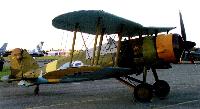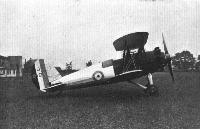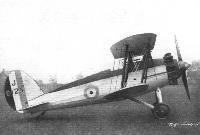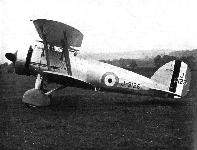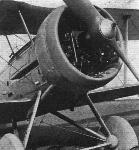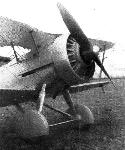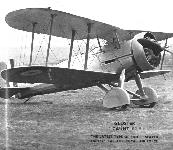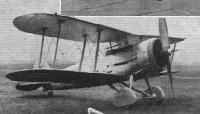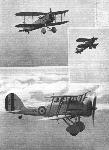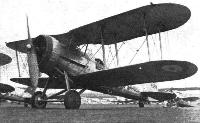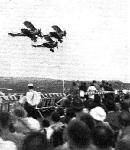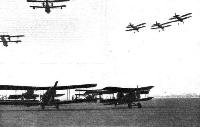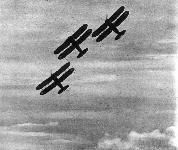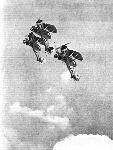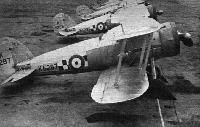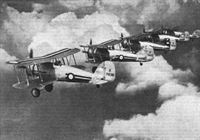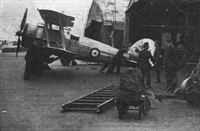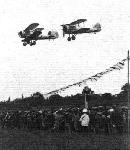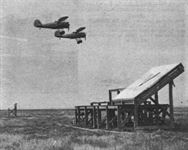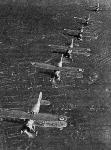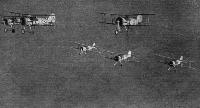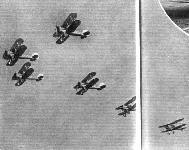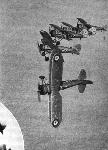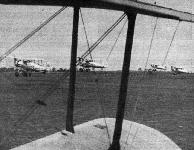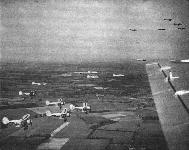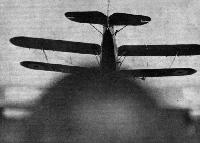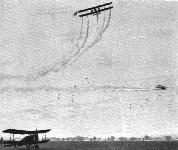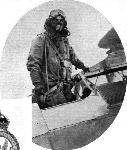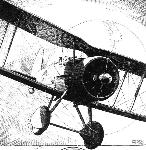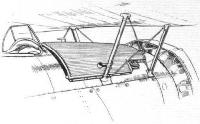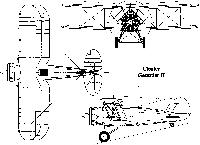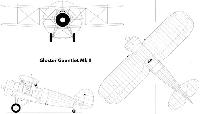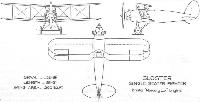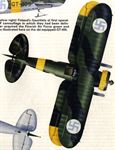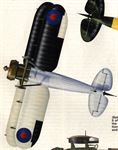
Gauntlet
Истребитель. Одномоторный биплан цельнометаллической конструкции с неубирающимся шасси. Спроектирован в КБ фирмы "Глостер эйркрафт" под руководством Г. Фолланда. Опытный самолет SS.18 впервые взлетел в январе 1929 г. За ним последовали SS.18A, SS.19, SS.19A и SS.19B. Последний запустили в серийное производство как "Гонтлит" I.
Истребитель выпускался на заводе "Глостер" в Хэкклкоте с февраля 1934 г. В 1936 г. сборку из импортированных узлов наладили также в мастерских ВВС в Дании. Всего выпущено 245 экз., из них 228 экз. - в Англии.
Самолет состоял на вооружении в Великобритании с февраля 1934 г., в Дании - с 1936 г., в Финляндии - с 1940 г.
Экипаж - 1 чел. Двигатель "Меркьюри" VIS2. Вооружение 2x7,69, бомбы до 90 кг (как полевая переделка).
Серийно выпускались модификации:
- "Гонтлит" I с двухлопастным винтом;
- "Гонтлит" II с трехлопастным винтом.
Как истребитель эксплуатировался ВВС Великобритании в метрополии до октября 1939 г. В 1939-40 гг. использовался как легкий штурмовик против повстанцев в Палестине. С мая 1940 г. служил в ПВО Каира. С лета того же года "гонтлиты" воевали в пустыне на границе Судана как легкие штурмовики и пикирующие бомбардировщики против итальянских войск, в том числе и ночью. В августе - сентябре 1940 г. они там же ограниченно применялись и как истребители. Известен один воздушный бой, в котором английский биплан сбил итальянский бомбардировщик Ca 133. Как штурмовики "гонтлиты" воевали и в Ливии осенью 1940 г. С конца года они использовались только в учебных целях.
Датские истребители были либо уничтожены на земле, либо захвачены немцами в апреле 1940 г. и больше не эксплуатировались. Финны получили партию самолетов "Гонтлит" II и использовали их как учебно-тренировочные.
"Гонтлит" сняли с производства в 1937 г.
Самолет был снят с вооружения в Англии в 1944 г., в Финляндии - в конце 1945 г.
"Гонтлит" II||
Размах:||19,9 м
Длина:||8,0 м
Моторы, количество х мощность:||1х620 л.с.
Взлетная масса, максимальная:||1800 кг
Максимальная скорость:||370 кг
Практический потолок:||10210 м
Дальность:||600 км
Описание:
- Gauntlet
- Gloster Gauntlet
- Flight, June 1929
BRITISH AIRCRAFT AT OLYMPIA - Flight, December 1929
THE GLOSTER S.S.8 - Flight, February 1931
THE GLOSTER S.S.19 - Flight, June 1931
SPECIAL TYPES AT THE DISPLAY - Flight, November 1932
British Aircraft - Flight, December 1933
THE GLOSTER. "GAUNTLET" - Flight, June 1934
THE GLOSTER "GAUNTLET"
Фотографии
-
Air International 1990-10 / Model enthusiast
Регистрационный номер: K5272 A Gauntlet II, K5272, of No 111 Squadron, RAF, at Northolt in March 1937. Black bar on the fuselage, repeated across the upper wing between the roundels, was the squadron marking, whereas black fin signified a flight leader's aircraft.
-
Мировая Авиация 140
Регистрационный номер: K7817 Gauntlet Mk II K7817, один из партии в 100 машин, был поставлен 54-й эскадрилье ВВС 8 октября 1936 года. Восемь месяцев спустя его передали 74-й эскадрилье в "тигриной" окраске (представлен на рисунке).
-
Air International 1990-10 / Model enthusiast
Регистрационный номер: K7843 [4] Gauntlet II K7843 of No 3 Squadron, RAAF, at Helwan in Egypt, November 1940. This squadron flew a number of dive-bombing operations with its Gauntlets for a few days in December 1940.
-
Мировая Авиация 79
Регистрационный номер: K7843 [4] Gloster Gauntlet Mk II. Считавшийся устаревшим Gauntlet в первые месяцы войны в Северной Африке еще находился на вооружении одной австралийской (на рисунке - самолет 3-й эскадрильи) и трех британских эскадрилий. Южноафриканские ВВС эксплуатировали самолеты в Восточной Африке вплоть до 1942 года.
-
Air International 1990-10 / Model enthusiast
Регистрационный номер: K7890 [2] Gauntlet II K7890 was on the strength of No 151 Squadron, RAF, at North Weald in 1937. The squadron marking was a narrow black bar centred on a broad pale blue bar, and was repeated on the wing upper surface.
-
Мировая Авиация 233
Регистрационный номер: K7890 [2] Этот Gauntlet Мк II служил в 151-й эскадрилье и в 1937 году базировался в Норт Уилде в Кенте. Нанесенные на хвостовую часть фюзеляжа и верхнюю поверхность верхнего крыла опознавательные знаки подразделения состояли из сужавшейся черной линии на фоне светло-голубой полосы. Эскадрилья летала на этих истребителях с середины 1936 до конца 1938 года.
-
Air International 1990-10 / Model enthusiast
Side view of a Gauntlet II of No 17 Squadron at Kenley in late 1938, after the Munich crisis had brought the hasty application of camouflage, obliteration of serial numbers
-
Air International 1990-10 / Model enthusiast
Регистрационный номер: J-21 In the markings of the Danish Haerens Flyvertropper (Army Aviation Troops), this Gauntlet had been built as the first production Mk 1 for the RAF and was later supplied to Denmark as a pattern aircraft for licence production.
-
Air International 1990-10 / Model enthusiast
A Danish-built Gauntlet of 1 Eskadrille, Haerens Flyvertropper at Vaerlose in early 1940. The camouflage colours had been adopted in 1939, with greenish yellow and dark greyish green on the upper surfaces and light grey-blue underside.
-
Мировая Авиация 19
Gloster Gauntlet. Этот самолет Gauntlet использовался 1-й эскадрильей Haerens Flyvertropper. На 9 апреля в строю насчитывалось 13 самолетов Gauntlet из 18 поставленных ВВС (один от фирмы "Gloster" и 17 построенных по лицензии). Все самолеты Flyvertropper базировались в Ваерлозе к северо-западу от Копенгагена.
-
Мировая Авиация 233
После получения одного самолета британской постройки в качестве эталона 17 истребителей Gauntlet Mk II были выпущены по лицензии в Дании. Базируясь в Ваерлозе, они несли службу в 1-й эскадрилье датских ВВС. Из 13 боеготовых на момент немецкого вторжения в апреле 1940 года машин большая часть была уничтожена на земле.
-
Air International 1990-10 / Model enthusiast
Регистрационный номер: GT-405 [3] Finland's Gauntlets at first operated in the RAF camouflage in which they had been delivered, but later acquired the Finnish Air Force green and black finish, as illustrated here on the ski-equipped GT-405.
-
Мировая Авиация 140
Регистрационный номер: GT-405 [3] Двадцать пять Gauntlet Mk II были переданы Финляндии после того, как они перестали удовлетворять требованиям британских ВВС. Этот самолет с лыжным шасси использовался весной 1942 года для обучения подразделением T/LeLv 35.
-
Air Enthusiast 1996-11 / K.Stenman - Gloster Trilogy
Регистрационный номер: GT-400 [9], OH-XGT [7] Restored from virtual scrap in the period 1976 to 1981, Gauntlet II GT-400 caught in her element during the summer of 1984. Built for the RAF in mid-1936 as K5271 it was used for trials at Boscombe Down and by Glosters until being transferred to Finland on December 22, 1939, along with K5270. Colours are as authentic as possible - the Author supplying the colour pattern and chips. The test series civil registration OH-XGT is carried for legal purposes in yellow on the rudder. A Mercury VI radial eluded the restoration team and in its place an Alvis Leonides 127 was installed which involved some changes in length and shape to the cowling. The aircraft is kept at the ‘Hallinportti Ilmailumuseo' at Haiti.
-
Air Enthusiast 1996-11 / K.Stenman - Gloster Trilogy
Регистрационный номер: GT-400 [9], OH-XGT [7] Gloster Gauntlet GT-400 (OH-XGT) aloft in the summer of 1984.
-
Air Enthusiast 1996-11 / K.Stenman - Gloster Trilogy
Регистрационный номер: GT-400 [9], OH-XGT [7] View of the surviving Finnish Gauntlet, GT-400/OH-XGT.
-
Air Enthusiast 1996-11 / K.Stenman - Gloster Trilogy
Регистрационный номер: GT-400 [9], OH-XGT [7] -
Мировая Авиация 233
Регистрационный номер: GT-400 [9], OH-XGT [7] Финские ВВС использовали Gauntlet в качестве учебных машин до 1950 года. Самолеты были поставлены в английском камуфляже, но впоследствии финны перекрасили их по своей схеме. В 1982 году из двух сохранившихся Mk II был собран один летный экземпляр. Он несет бортовой номер GT-400 и регулярно участвует в различных авиационных показах. Снимок сделан в июне 2006 года на авиашоу в Каухава.
-
Мировая Авиация 233
Регистрационный номер: J9125 [16] Один самолет (J-9125) послужил основой для разработки опытных вариантов на базе самолетов S.S.18 и S.S.19. Он оснащался различными силовыми установками и вариантами вооружения. На снимке представлен S.S.18A с 480-сильным (358 кВт) ПД Jupiter VIIF.
-
Flight 1929-07 / Flight
Регистрационный номер: J9125 [16] GLOSTER S.S. FIGHTER (Bristol "Mercury IIa").
-
Flight 1929-12 / Flight Advertisements
Регистрационный номер: J9125 [16] GLOSTER S.S.19. SINGLE-SEATER FIGHTER IN METAL.
-
Flight 1929-12 / Flight
Регистрационный номер: J9125 [16] -
Aeroplane Monthly 1985-08 / A.Lumsden, T.Heffernan - Probe Probare (15)
Регистрационный номер: J9125 [16] The Gloster SS.18A, J9125, photographed in 1929 with the Jupiter VIIF engine installed.
-
Flight 1929-12 / Flight
Регистрационный номер: J9125 [16] -
Flight 1933-12 / Flight Advertisements
Регистрационный номер: J9125 [16] GLOSTER "GAUNTLET" (s.s. 19b)
-
Мировая Авиация 82
Регистрационный номер: J9125 [16] Январь 1929г.: впервые взлетел самолет Gloster SS.18 (код J9125), пилотируемый Говардом Сзйнтом. После доработки этот самолет получил наименование SS.19В Gauntlet.
-
Flight 1931-02 / Flight
Регистрационный номер: J9125 [16] THE GLOSTER S.S.19. OR MULTI-GUN MACHINE IS ARMED WITH NO LESS THAN 6 MACHINE GUNS
J9125 as the SS.19, fitted with six 0-303in machineguns. Two Vickers guns were carried in the fuselage and two Lewis guns were located under the top and bottom wings. -
Aeroplane Monthly 1985-08 / A.Lumsden, T.Heffernan - Probe Probare (15)
Регистрационный номер: J9125 [16] J9125 as the SS.19B.
-
Flight 1933-12 / Flight
Регистрационный номер: J9125 [16] -
Flight 1933-12 / Flight
MODERNITY: Showing the exceptionally clean nose and undercarriage. It is likely that the nose of the production "Gauntlet" will differ from that shown, as a newer type of "Mercury" and cowling may be used.
-
Flight 1933-12 / Flight Advertisements
GLOSTER "GAUNTLET" - THE LATEST TYPE OF SINGLE SEATER FIGHTER FOR THE ROYAL AIR FORCE
-
Flight 1935-12 / Flight
Gloster Gauntlet (605 h.p. Mercury VI S)
-
Jane's All the World Aircraft 1938 / 03 - All the world's aeroplanes
A Danish-built Gloster "Gauntlet" Single-seat Fighter Biplane (Bristol "Mercury" engine).
-
Air-Britain Aeromilitaria 1982-03
Gauntlet of No.19 Squadron
-
Aeroplane Monthly 1988-09 / P.Cooksley - RAF Kenley. Bulwark of London (1)
A 615 Sqn Gauntlet firing live ammunition at the stop-butts adjacent to No 2 hangar on Empire Air Day 1939.
-
Aeroplane Monthly 1985-08 / A.Lumsden, T.Heffernan - Probe Probare (15)
Регистрационный номер: J9125 [16] J9125 as the SS.19B being demonstrated for Charles Sims’ camera, probably at Brockworth.
-
Flight 1935-01 / Flight Advertisements
Регистрационный номер: J9125 [16] -
Aviation Historian 1 / G.Warner - Why was the "Bristol" Mercury so long lived?
Регистрационный номер: J9125 [16] Тот же самолет, что и на предыдущей фотографии, после переделки в вариант S.S.19B с обтекателями на всех трех стойках шасси и без четырех пулеметов под крылом, как у S.S.19. На серийных Gauntlet обтекатели колес не устанавливались.
Seen here fitted with a Mercury VIS.2 in a narrow-chord cowling with leading-edge exhaust collector ring, Gloster SS.19B J9125 was much tested with various Bristol powerplants and became the prototype for the Gauntlet, which itself would be developed into the Mercury-powered Gladiator. -
Flight 1934-04 / Flight
Регистрационный номер: J9125 [16] TRYING IT OUT: The Gloster "Gauntlet" shown in these photographs is fitted with the Bristol "Mercury VI" engine and a special Townend ring. THe pilot was Capt. Saint.
-
Aeroplane Monthly 1985-08 / A.Lumsden, T.Heffernan - Probe Probare (15)
Регистрационный номер: J9125 [16] The same aircraft, now designated SS.19B and fitted with a Mercury VIS2 engine, being test flown as the Gauntlet prototype from Brockworth in April 1934.
-
Air Pictorial 1977-07 / M.Bowyer - R.A.F. on Parade - the 1935 Jubilee Review
No.19 Squadron re-equipped with Gloster Gauntlets a few weeks before the Review
-
Flight 1935-06 / Flight
Gloster Gauntlet Is from Henlow, June 1935
Gloster Gauntlets were the main equipment of 14 Fighter Command squadrons in 1937. By 1939 the type had been replaced by the Gladiator and Hurricane though on the outbreak of war some RAF Auxiliary squadrons had a number still in service. In 1936 the Gauntlet was the fastest RAF fighter in service. -
Мировая Авиация 233
Регистрационный номер: K4083, K4084 [2], K4087, K4088 [2], K4090 [2] На пике своей карьеры Gauntlet состоял на вооружении 14 эскадрилий британских ВВС, большинство из которых были оснащены вариантом Mk II. Gauntlet Mk I на снимке принадлежали 19-й (истребительной) эскадрилье, базировавшейся в Даксфорде на юге Англии.
-
Aviation Historian 10 / R.Pegram - Folland's Forgotten Monoplanes (2)
Регистрационный номер: K4084 [2], K4088 [2], K4090 [2] GLOSTER GAUNTLET II: Fighter (Mercury VIS engine - 645 h.p. at 15,500ft.); span, 32ft. 9 1/2in.; gross weight, 3,970 lb.; max. speed, 230 m.p.h. at 15,500ft.
The "Gauntlet" employ the 605 h.p. "Mercury VIS" air-cooled radial.
Folland’s reputation as a designer of exceptional biplane fighters was cemented with the robust and agile Gauntlet, which entered RAF service in May 1935. The first unit to receive the type was No 19 Sqn, three Gauntlet Is of which are seen here up from the squadron’s base at Dux ford in the early summer of 1935. -
Flight 1936-06 / Flight
Регистрационный номер: K4094 [5] The Gloster Gauntlet is single-seater, being in the day-and-night fighting category. The Gauntlet has the 605 h.p. Bristol Mercury VIS.
-
Flight 1936-11 / Flight
Регистрационный номер: K4094 [5], K4100 [2] The Mercury-engined Gloster Gauntlet is well established in the R.A.F.
-
Flight 1935-06 / Flight
Регистрационный номер: K4094 [5] POETRY OF ACTION: This graphic picture of the new "Mercury"-engined "Gauntlets" of No. 19 (Fighter) Squadron in a concerted dive was secured by a Flight photographer from a two-seater "Bulldog" flying as one of the formation. The air drill by this unit - in all probability the best equipped of its kind in the world - will form a high-light in a brilliant programme at Hendon next Saturday.
-
Flight 1935-08 / Flight
Регистрационный номер: K4094 [5] No. 19 (Fighter) Squadron flying its "Gauntlet Is." The latest type of "Gauntlet" differs in certain ways from this mark, but the variations, which are of a structural nature, are not externally obvious.
-
Flight 1937-09 / Flight
The three Gauntlets of No. 111 (F) Sq. are concluding one of their two shows.
-
Flight 1936-07 / Flight
The old and the new: Gloster Gauntlets over two equally famous fighters from another epoch - the Bristol Fighter and the S.E.5s.
Другие самолёты на фотографии: Bristol F.2A/F.2B Fighter - Великобритания - 1916RAF S.E.5 - Великобритания - 1916
-
Flight 1936-06 / Flight
CLOVER IN THE CLOUDS: The trefoil pattern made by the three Gloster Gauntlets of No. 19 (F.) Squadron as they make their almost literally breath-taking manoeuvres in unison at the R.A.F. Display on June 27 will be watched by thousands. In this Flight photograph - the first aerial picture of this remarkable performance by the Gauntlets - we are shown the linked trio at close quarters.
-
Aeroplane Monthly 1985-08 / A.Lumsden, T.Heffernan - Probe Probare (15)
Регистрационный номер: K4094 [5], K4100 [2] Three 19 Squadron Gauntlet Is performing at RAF Henlow in June 1936.
-
Flight 1936-06 / Flight
From the ground, spectators see the "flight aerobatics" event, to be given at the R.A.F. Display by Gauntlets of No. 19 (F.) Squadron as an example of perfect team work, entailing seemingly superhuman co-ordination of speed and manoeuvring. From the air, flying near at hand as did Flight's chief photographer when he secured this fine impression of the machines starting a loop, a new angle of appreciation is obtainable.
-
Flight 1937-05 / Flight
Formation aerobatics by a trio of the tractable Gloster Gauntlets now in service.
-
Мировая Авиация 233
Регистрационный номер: K5265 [3] В мае 1936 года 56-я и 111-я эскадрильи стали первыми подразделениями, получившими на вооружение усовершенствованный вариант Gauntlet Mk II. На снимке: самолеты из знаменитой 111-й ("Treble One") эскадрильи.
-
Flight 1936-08 / Flight
Регистрационный номер: K5265 [3] ALERT: A fine study of Gauntlets of No. 111 (Fighter) Squadron at Biggin Hill being prepared to intercept a raid during last week's Air Exercises.
-
Aeroplane Monthly 1990-11 / Personal album. Military
Регистрационный номер: K5265 [3] Gloster Gauntlet K5265 taking part in the Headquarters Race at the 1936 RAF Pageant at Hendon on June 2. A pair of Gauntlets was entered, one of which won. Delivered to the RAF early in 1936, K5265 was first taken on strength on 111 Squadron at RAF Northolt. It later flew with Nos 79 and 601 Squadrons but was damaged beyond repair on February 8, 1941.
-
Aeroplane Monthly 1985-08 / A.Lumsden, T.Heffernan - Probe Probare (15)
Регистрационный номер: K5287 [4], K5296 [3], K5297 [2], K5300 [3] A formation of 56 Sqn Gauntlets flying from RAF North Weald in October 1936. The squadron received the type in May 1936 to replace its Bristol Bulldogs.
-
Flight 1936-12 / Flight Advertisements
Регистрационный номер: K5287 [4], K5296 [3], K5297 [2], K5300 [3] -
Flight 1936-12 / Flight
Регистрационный номер: K5287 [4], K5288 [3] No. 56 Squadron to-day: At the alarm the pilots run to their machines and clamber into their seats.
-
Flight 1936-12 / Flight
Регистрационный номер: K5287 [4], K5288 [3], K5289 The red and white diced pattern is the distinguishing mark of No. 56 (Fighter) Squadron, still as efficient a body as it was in the days of Ball and McCudden.
-
Flight 1936-12 / Flight
Регистрационный номер: K5288 [3] Not exactly the velvet gloves, for one can see the Gloster Gauntlets though one cannot see the Bristol Mercury engines inside the cowlings. All pilots love the Gauntlet, and will be sorry when the day comes for reequipment.
-
Aeroplane Monthly 1985-08 / A.Lumsden, T.Heffernan - Probe Probare (15)
Регистрационный номер: K5296 [3] Истребитель "Гонтлит" I британских ВВС
The Gloster Gauntlet single-seater day-and-night fighter
A fine study of 56 Sqn Gauntlet K5296 up from RAF North Weald in October 1936. This aircraft later flew with 17 Sqn. -
Flight 1937-01 / Flight
Регистрационный номер: K5300 [3] "IN THE BOX": The initiated know that this expression means flying behind the leader of a V formation with the arms of the V on either side. It is a good position for observing the quick reactions necessary to keep each machine in perfect formation. Our chief photographer assures us that half an hour in the box with the Gloster Gauntlets of No. 56 (F) Squadron is quite an interesting experience.
-
Flight 1937-05 / Flight
Регистрационный номер: K5309 The air raid alarm is sounding as pilots run to their Gloster Gauntlets, already being started by the ground crew.
-
Aeroplane Monthly 1988-09 / P.Cooksley - RAF Kenley. Bulwark of London (1)
Регистрационный номер: K5315, K7843 [4] 46 Sqn Gauntlet IIs being refuelled at RAF Kenley in 1936. K5315 crashed while taking off from Kenley on June 17, 1937.
-
Авиация и Космонавтика 2018-09 / В.Морозов - В желтой, жаркой Африке: Авиация Родезии и Зимбабве (1)
Регистрационный номер: K7843 [4] Камуфлированные Mk II из 111-й эскадрильи на аэродроме Нортхолт под Лондоном, 1936 год. Самолет на переднем плане в 1940 году нес службу в Египте, а вторую машину в том же году передали Финляндии.
-
Air Enthusiast 1971-09 / R.Braybrook - Biplane Era: The Flight from Reality /Fighters in the RAF/ (1)
Регистрационный номер: K7796 The Gloster Gauntlet was one of nine types of fighter biplane ordered into production for the RAF between 1918 and 1938, each representing only a small advance in performance over its predecessor. Illustrated are the Gauntlets of No 46 Squadron; another 21 squadrons flew the type.
-
Flight 1938-05 / Flight
Регистрационный номер: K7838, K7840 A close line-abreast by Gloster Gauntlet single-seater fighters. The Gauntlet has two guns, does 230 m.p.h., and is very manoeuvrable.
-
Flight 1936-08 / Flight
THE GRASP OF STEEL: A Gloster Gauntlet of No. 111 (Fighter) Squadron about to take oft from Biggin Hill to intercept air-exercise raiders.
-
Aeroplane Monthly 1985-08 / A.Lumsden, T.Heffernan - Probe Probare (15)
Gauntlets of 111 Squadron during Air Exercises at RAF Biggin Hill in 1936.
-
Flight 1938-05 / Flight
Gauntlet single-seater fighters being put to bed in Bessoneau hangars at No. 3 Armament Training Station, Sutton Bridge. The transportable Bessoneau hangar, which was of great service during the war, still has its uses in the R.A.F. to-day.
-
Jane's All the World Aircraft 1980 / Encyclopedia of Aviation - Aircraft A-Z - v3
Gloster Gauntlets in 1938.
-
Flight 1938-06 / Flight
The stop-butts scene is also at Kenley; the machine that is firing is a Gloster Gauntlet.
-
Flight 1938-08 / Flight
The crowd in the official enclosure with a background of Gauntlets. The rest of the ten thousand are out of the picture to the right. Some idea of the conditions will be gathered from the fact that the clouds were sometimes touching the low hills seen in the distance.
-
Aeroplane Monthly 1994-12 / G.Wansbrough-White - What's in a name? (2)
THE STAGE SET: This aerial photograph of the Royal Air Force Display machines assembled in the operational park at Hendon forms a fitting introduction to the pictures, in the ensuing pages, of the Display in progress. There are eight monoplanes in the assembly - Ansons (third row) and Clouds (fifth).
Line-up of about 130 1936 RAF Display participants - all biplanes except for the Ansons and Saro Cloud amphibians.
The stage is set for the 1936 RAF Display at Hendon. The monoplanes (Ansons and Saro Clouds) are totally outnumbered by the biplanes including Heyfords, Bulldogs, Gauntlets, Fairey IIIFs, Harts, Hinds, Tiger Moth, Overstrands etc, etc. This entire area has since disappeared beneath a sea of bricks and concrete.Другие самолёты на фотографии: Avro Anson / Type 652 - Великобритания - 1935Boulton Paul Overstrand / P.75 - Великобритания - 1933Bristol Bulldog - Великобритания - 1927De Havilland Tiger Moth / D.H.82 - Великобритания - 1931Fairey Fairey IIIF - Великобритания - 1926Handley Page Heyford / H.P.38 / H.P.50 - Великобритания - 1930Hawker Hart - Великобритания - 1928Hawker Hind - Великобритания - 1934Saunders-Roe Cloud / A.19 - Великобритания - 1930
-
Air Enthusiast 1973-03 / H.Taylor - Gloster Gladiator /Viewed from the Cockpit/
The Gladiator's immediate forerunner, the Gauntlet.
-
Flight 1936-06 / Flight
The three Gloster Gauntlets of No. 19 Squadron, which put up a magnificent tied-together display.
-
Flight 1938-05 / Flight
A pair of Gloster Gauntlet single-seaters over the ranges at No. 3 Armament Training Station, Sutton Bridge.
-
Flight 1936-12 / Flight
A little fancy flying: No. 56 F.S. shows that it can fly in line astern
-
Flight 1936-12 / Flight
In battle formation: Six Gauntlets up on patrol, searching the skies for the raiding bombers.
-
Flight 1935-07 / Flight
The comparative silence of the Gloster "Gauntlets" of No. 19 (F.) Squadron was generally commented upon when they carried out squadron air drill.
-
Flight 1937-06 / Flight
Gloster Gauntlet fighters in squadron formation.
-
Flight 1936-12 / Flight
Dive bombing: From echelon on the right, the leader cartwheels down for an attack on a ground target.
-
Flight 1937-07 / Flight
An ever-popular item - smoke evolutions. They were performed by five Gauntlets of No. 66 (F.) Squadron.
-
Flight 1935-06 / Flight
Gloster "Gauntlets" of No. 19 (Fighter) Squadron - the latest and fastest type of fighter in service in the world. Its top speed at 15,800 feet is 230 m.p.h. These remarkable Flight photographs were taken from a two-seater "Bulldog" which flew as a member of the single-seater formation.
Другие самолёты на фотографии: Bristol Bulldog - Великобритания - 1927
-
Flight 1937-06 / Flight
SKY PARADE: Gauntlets, Ansons and Harrows in a "skeleton flight" rehearsal for the massed fly-past which will feature in the RA.F. Display to be held at Hendon on June 26. It is to be hoped that the squadrons will fly at closer intervals and at a lower altitude than did those in the so-called fly-past of two years ago.
Другие самолёты на фотографии: Avro Anson / Type 652 - Великобритания - 1935Handley Page Harrow / H.P.54 - Великобритания - 1936
-
Flight 1935-05 / Flight
Другие самолёты на фотографии: Hawker Hart - Великобритания - 1928
-
Flight 1935-05 / Flight
The photograph illustrate the attack of a flight of "Gauntlets" on a flight of "Harts." In the picture one fighter is seen on the left, coming up behind and below the starboard bomber, while two "Gauntlets," one behind the other, are stalking the port bomber which appears on the right of the picture.
Другие самолёты на фотографии: Hawker Hart - Великобритания - 1928
-
Flight 1935-05 / Flight
Another view of the attack by the "Gauntlets," which shows still more clearly one fighter tackling the starboard bomber while two approach the port bomber. If their attacks are successful the leading "Hart" will be left alone to deal with all three fighters.
Другие самолёты на фотографии: Hawker Hart - Великобритания - 1928
-
Flight 1935-05 / Flight
The photograph illustrate the attack of a flight of "Gauntlets" on a flight of "Harts." In the picture is shown the view of the gunner in the port "Hart" as the two fighters approach him. He dare not fire at them for fear of hitting his own fin, but must trust to cross fire from the "Hart" on his starboard side.
Другие самолёты на фотографии: Hawker Hart - Великобритания - 1928
-
Flight 1935-05 / Flight
Another view from the gunner's cockpit in the port "Hart." Note how the fighter pilots are shielded by their "Mercury" engines.
Другие самолёты на фотографии: Hawker Hart - Великобритания - 1928
-
Flight 1935-05 / Flight
This remarkable photograph shows the attack from the fighter's point of view. The head of the fighter pilot is naturally out of focus. He has now got into position in the blind spot below the "Hart" and is about to riddle it with bullets from his two Vickers guns.
Другие самолёты на фотографии: Hawker Hart - Великобритания - 1928
-
Flight 1936-07 / Flight
The trusty old Virginias' only (and probably last) Hendon Display item - parachute escapes by the "crews" of bombers attacked and set on fire by Gauntlets of No. 111 (F) Squadron; note the war-time S.E.5a on the ground.
Другие самолёты на фотографии: RAF S.E.5 - Великобритания - 1916Vickers Virginia - Великобритания - 1922
-
Flight 1937-09 / Flight
The two leading machines, the Klemm in the foreground and the V.E.F. on the left. Two of the four Gauntlets at the meeting may be distinguished in the background.
Другие самолёты на фотографии: Irbitis, VEF I-11 / I-12 / I-17 - Латвия - 1936Klemm Kl.35 / Kl.106 - Германия - 1935
-
Авиация и Космонавтика 2022-01 / В.Морозов - "Битва" за Сингапур (1)
Британские истребители Глостер «Гонтлет» на одном из аэродромов Сингапура. Фото 1936 г.
-
Air Enthusiast 1996-11 / K.Stenman - Gloster Trilogy
Регистрационный номер: GT-396 [2], GT-398, GT-402, GT-408 [3], GT-411, GT-414 [2], GT-416, GT-418 Eight Gauntlets in a line-up at the Tampere depot in October 1941, many going for a thorough overhaul at the aircraft factory. The machines are: GT-408 (code ‘3’), 414, 411, 418, 396, 402, 416 (‘2’) and 398.
-
Мировая Авиация 233
Когда в ноябре 1939 года началась война между СССР и Финляндией, правительство Южной Африки передало последние 24 истребителя Gauntlet, поставленные в 1940 году, Финляндии. Самолеты были предназначены для борьбы с советскими войсками.
-
Air Enthusiast 1996-11 / K.Stenman - Gloster Trilogy
Регистрационный номер: GT-408 [3] Gauntlet GT-408 of ‘Lentolaivue’ 30 based at Pori during winter 1940-41. In typical British colours of early 1940, having black and white undersurfaces and dark green over dark earth upper surfaces.
-
Air Enthusiast 1996-11 / K.Stenman - Gloster Trilogy
Регистрационный номер: GT-399 GT-399 was the first Gauntlet to he painted in the Finnish war camouflage of olive green and black over light blue-grey. It is being serviced at Utti in late July 1942 attached to T-LLv 35.
-
Air Enthusiast 1996-11 / K.Stenman - Gloster Trilogy
Регистрационный номер: GT-414 [2] GT-414 logged record 521 hours in Finland, seen here at Kauhava on March 3, 1943, issued to the ‘Lentosotakoulu ’, wearing the standard late war camouflage with full yellow Eastern Front markings.
-
Air Enthusiast 2001-07 / K.Stenman - From Britain to Finland
Регистрационный номер: GT-396 [2] GT-396 was one of the 24, out of the promised 28, Gauntlet IIs donated by the Federation of South Africa. Upon arrival, this machine was assigned to an advanced training squadron, Lentolaivue 29, based at Tyrvanto.
-
Aeroplane Monthly 1982-06
Регистрационный номер: GT-400 [9] This Finnish Air Force Gloster Gauntlet II GT-400, ex-RAF K5271, is currently under restoration at the Air Force Technical School at Halli, Finland. An Alvis Leonides engine has been installed in the absence of a Bristol Mercury and the aircraft is due to fly this summer.
-
Air-Britain Archive 1982-02
Регистрационный номер: GT-400 [9], OH-XGT [7] The first flight of a civil-registered Gloster Gladiator is an event well worth recording and we have just received this shot of OH-XGT taken on the day of its first flight after prolonged rebuild, at Halli 10.5.82. The Gladiator wears Finnish Air Force colours and the serial GT-400 in addition to civil marks.
-
Aeroplane Monthly 1984-02 / E.Ritaranta - Picking up the Gauntlet
Регистрационный номер: GT-400 [9], OH-XGT [7] The Finnish Gloster Gauntlet, GT-400/OH-XGT, in the air in September 1983.
-
Aeroplane Monthly 1984-02 / E.Ritaranta - Picking up the Gauntlet
Регистрационный номер: GT-405 [3] "Гонтлит" I, использовавшийся в Финляндии как учебный самолет, 1943 г.
GT-405 issued to T-LLv 35, an advanced training squadron, at Vesivehmaa during winter 1941-42. The ski design is a 1925 vintage and was used by many types of aircraft up until the 1960s. -
Aeroplane Monthly 1984-02 / E.Ritaranta - Picking up the Gauntlet
A pair of wheels from a Polikarpov I-16 replaced the original Gauntlet undercarriage.
-
Aeroplane Monthly 1984-02 / E.Ritaranta - Picking up the Gauntlet
Регистрационный номер: GT-400 [9] Detail of the cockpit area of GT-400, photographed in June 1978.
-
Flight 1936-12 / Flight
A pilot is shown wearing his R/T and oxygen apparatus.
-
Flight 1938-01 / Flight
KIT, or the White Man's Burden: A story without words from N<...> regalia shown, including parachute, is said to weigh 58 3/4 lb.
-
Aeroplane Monthly 1984-02 / E.Ritaranta - Picking up the Gauntlet
Регистрационный номер: GT-408 [3] Gauntlet GT-408 in a compromising position in summer 1940. The RAF camouflage can be clearly seen.
-
Flight 1933-12 / Flight Advertisements
GLOSTER "GAUNTLET" DAY AND NIGHT FIGHTER
-
Flight 1935-05 / Flight Advertisements
The GLOSTER "GAUNTLET" Bristol "Mercury" VI Engine. General Purpose Fighter as adopted by the Royal Air Force and the Royal Danish Army Air Service.
-
Flight 1934-07 / Flight
ON THE GLOSTER "GAUNTLET": The oil cooler on top of the fuselage deck.
-
Flight 1935-06 / Flight
HERALDRY at HENDON: "Gauntlet" No. 19 (F.) Squadron
-
Мировая Авиация 140
Gloster Gauntlet Mk II
-
Air Enthusiast 1996-11 / K.Stenman - Gloster Trilogy
Gloster Gauntlet
-
Flight 1929-07 / Flight
Gloster Single Seater Fighter Bristol "Mercury IIA" Engine
-
Air International 1990-10 / Model enthusiast
Finland's Gauntlets at first operated in the RAF camouflage in which they had been delivered, but later acquired the Finnish Air Force green and black finish, as illustrated here on the ski-equipped GT-405.
-
Air International 1990-10 / Model enthusiast
Plan view of a Gauntlet II of No 17 Squadron at Kenley in late 1938, after the Munich crisis had brought the hasty application of camouflage, obliteration of serial numbers
Тип фотографий
- Все фото (126)
- Боковые проекции (13)
- Цветные фото (5)
- Ч/б фото (96)
- Обломки (1)
- Рисунки, схемы (11)

















